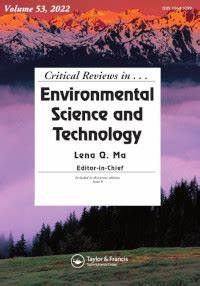Mercury transformations by reactive oxygen species: Occurrence, detection, evidence, and challenges
IF 13.2
1区 环境科学与生态学
Q1 ENVIRONMENTAL SCIENCES
Critical Reviews in Environmental Science and Technology
Pub Date : 2025-03-11
DOI:10.1080/10643389.2025.2478037
引用次数: 0
Abstract
Mercury (Hg) is a global pollutant that has attracted widespread attention due to its potent toxicity to humans. The transformations of Hg are critical to its global cycling and human exposure risk, considering that different Hg forms possess various mobility and toxicity. It is, therefore, essential to explore the mechanisms of Hg transformations. Both biotic and abiotic factors mediate Hg transformations in the environments, while the latter has not been sufficiently recognized, among which reactive oxygen species (ROS) are ubiquitous yet potentially overlooked drivers. This insufficient recognition of ROS-mediated Hg transformations impeded our understanding of Hg biogeochemistry. Herein, we summarized the generation mechanisms of ROS in the atmosphere, natural water, and soil, and elucidated ROS involvement in Hg transformations, including MeHg degradation, Hg0 oxidation, and Hg(II) reduction. Then, approaches for exploring the role of ROS in Hg transformations were introduced, including ROS detection, quenching, generation, and DFT calculations. By summarizing the implications of ROS-mediated Hg transformations for Hg biogeochemical cycling and proposing potential challenges in further studies, we highlight the importance and necessity of studying this driving force in Hg biogeochemistry.由活性氧引起的汞转化:发生、检测、证据和挑战
汞(Hg)是一种全球性的污染物,因其对人体的毒性而受到广泛关注。考虑到不同形式的汞具有不同的流动性和毒性,汞的转化对其全球循环和人类暴露风险至关重要。因此,对汞的转化机理进行研究是十分必要的。生物和非生物因素都介导环境中汞的转化,而后者尚未得到充分认识,其中活性氧(ROS)是普遍存在但可能被忽视的驱动因素。这种对ros介导的汞转化的认识不足阻碍了我们对汞生物地球化学的理解。本文综述了大气、天然水和土壤中ROS的生成机制,并阐明了ROS参与汞转化,包括MeHg降解、Hg0氧化和Hg(II)还原。然后,介绍了探索ROS在汞转化中的作用的方法,包括ROS检测、猝灭、生成和DFT计算。本文总结了ros介导的汞转化对汞生物地球化学循环的影响,并提出了进一步研究的潜在挑战,强调了研究这一驱动力在汞生物地球化学中的重要性和必要性。
本文章由计算机程序翻译,如有差异,请以英文原文为准。
求助全文
约1分钟内获得全文
求助全文
来源期刊
CiteScore
27.30
自引率
1.60%
发文量
64
审稿时长
2 months
期刊介绍:
Two of the most pressing global challenges of our era involve understanding and addressing the multitude of environmental problems we face. In order to tackle them effectively, it is essential to devise logical strategies and methods for their control. Critical Reviews in Environmental Science and Technology serves as a valuable international platform for the comprehensive assessment of current knowledge across a wide range of environmental science topics.
Environmental science is a field that encompasses the intricate and fluid interactions between various scientific disciplines. These include earth and agricultural sciences, chemistry, biology, medicine, and engineering. Furthermore, new disciplines such as environmental toxicology and risk assessment have emerged in response to the increasing complexity of environmental challenges.
The purpose of Critical Reviews in Environmental Science and Technology is to provide a space for critical analysis and evaluation of existing knowledge in environmental science. By doing so, it encourages the advancement of our understanding and the development of effective solutions. This journal plays a crucial role in fostering international cooperation and collaboration in addressing the pressing environmental issues of our time.

 求助内容:
求助内容: 应助结果提醒方式:
应助结果提醒方式:


